- All You Need to Know
Toning Abdominal Muscles
Toning abdominal muscles has ideas from a book by Adam Weiss. This is excellent for those bored with gyms but do want at home to have a safe and proven program to produce a flat belly and strong back; without straining your back.
As a chiropractor of forty years vintage I can vouch for the fact that a simple program of back and abdominal exercises, done daily, would put a lot of my colleagues, not to mention neurosurgeons out of business.
Regaining your strong core muscles is vital after Chiropractic treatment for your ailing back; particularly the deeper transverse muscle, because it is closer to the spine, and thus more effective.
The question though is which are the best abdominal muscle exercises so that you will not simultaneously screw up your back, or your neck.
Sit-ups and crunches are probably fine for that small minority who have had no neck or back injuries. For the rest, most of us, there are better and safer ways to strengthen your lower abdominal muscles.
"Traditional ab exercises can cause back pain, strained muscles and can even cause misalignment."
- Dr Adam Weiss, DC.
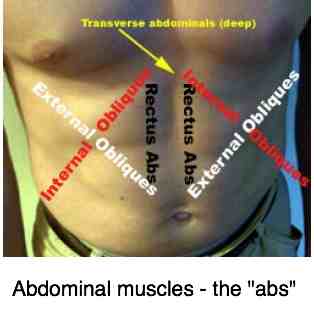
STRENGTHEN YOUR CORE WITHOUT STRAINING YOUR BACK.
The Ab muscles
Building abdominal muscles means focusing on all these muscles. Because two of them come in pairs, there are really only FOUR to consider.
- The TRANSVERSE abdominal muscle - the deepest and thus most important CORE muscle.
- The INTERNAL oblique abdominal muscle
- The EXTERNAL oblique abdominal muscle
- The RECTUS abdominal muscle - the most superficial, the one that you can see prominently on Mr Atlas, perhaps the least important of the four, but most important if all you want to do is impress!
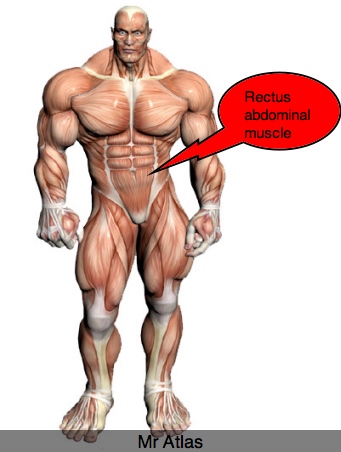
This is not an anatomy lesson, so we'll run through the other three very quickly.
The TRANSVERSE abdominal muscle
Abdominal muscle exercise is vital if you have a weak back, particularly this muscle which runs (simplified) from the ILIAC CREST and the ribs transversally to the midline.
It's a vital part of the 'pelvic corset' of muscles that hold in the abdominal contents and you use it every time you lift something heavy (note how you take in a deep breath and hold it as you lift: Transversis Abdominis), in a bowel movement and singularly important in labour.
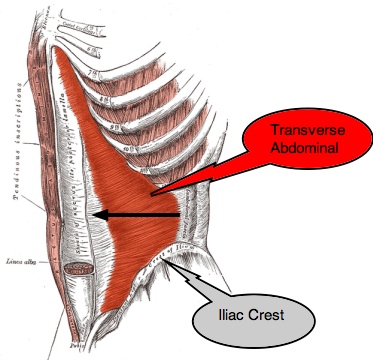
The INTERNAL OBLIQUE
As you can see from the picture below, this muscle also runs from the ILIAC CREST just below the waist upwards and towards the midline, where it inserts into the lower ribs (and other structures).
It rotates the body towards the hip, and laterally flexes the trunk (side-bends). Exercise for lower abdominal muscles is very important.
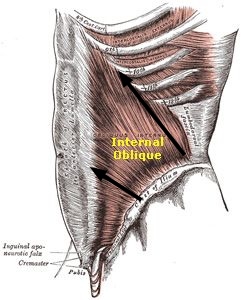
The EXTERNAL OBLIQUE
This muscle also helps to tighten the belly and to rotate to the opposite side. It's really a pretty flimsy little muscle, not unimportant though in the context of toning abdominal muscles.
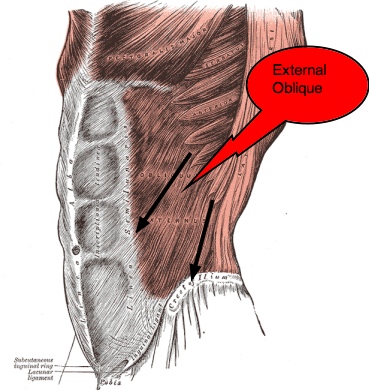
Every chiropractor will attest to the fact that s/he regularly treats patients who have injured themselves whilst trying to tone abdominal muscles.
Chiropractor Adam Weiss himself suffered from an early age from back pain (that's how most of us get into chiropractic!) forcing him to adapt and modify his exercise program for the abdominal muscles. Out of this synthesis he has now scripted an excellent book for toning abdominal muscles.
The AbSmart Fitness Plan
Lose inches and strengthen your core WITHOUT STRAINING YOUR BACK.
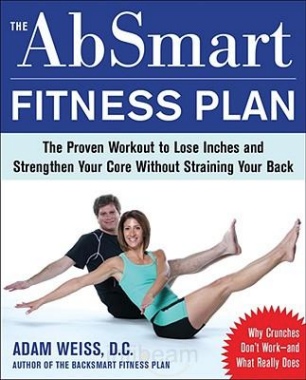
The book comes in three parts. Getting started, your workout and putting it all together.
There is quite a lot on the food required to produce a lean waistline, beating the bloat and how we eat.
Toning Abdominal Muscles
Toning Abdominal Muscles looks at strengthening your core without straining your back.
- Home >
- Lower back exercises >
- Toning Abdominal Muscles
Did you find this page useful? Then perhaps forward it to a suffering friend. Better still, Tweet or Face Book it.
